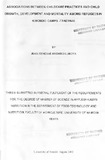| dc.description.abstract | In emergencies, despite food ration distribution, presence of feeding programmes and
provision of free health cares, malnutrition and morbidity are still a problem that
constitute a threat to child survival, growth and development, and information on
childcare practices are scarce.
In order to investigate the influence of childcare practices on child nutritional status,
growth and development, morbidity and mortality, a cross sectional study was conducted
in Kibondo refugee camps in Tanzania. Data were collected during the period between
November 2000 and February 2001 in four refugee camps. The sample size comprised
364 pair mothers/children aged 6-24 months in 364 households living in the camps. A
structured questionnaire with few open-ended questions was used as a guideline to data
collection on childcare practices, anthropometry, food intakes, dentition, developmental
milestones, morbidity and mortality. Data management, entry, cleaning and analysis was
done using the Epi Info 2000 (version 1.0), the Nutrisurvey update 2000 and the
statistical package for social sciences (SPSS version 8.0) packages.
The nutritional status has deteriorated compared to previous surveys. About 6.3% (95%
CI: 4.1-9.4%) of children were suffering from acute malnutrition or wasting, 28.5% (95%
CI: 24-33.5%) were underweight and 42.7% (37.6-48%) were suffering from chronic
malnutrition or stunting. High morbidity (65%) was found among children with high
incidence of diarrhoea (48.2%). The Under five mortality rate was 0.75110.000 per day.
The results of the study showed that household size and birth order, duration in the camp,
household wealth, amount of financial support to the mother and availability of water in
the household are the factors which affect household caring capacity.
Childcare practices that showed associations with child nutritional status, growth, disease
incidence and mortality of children are: time allocated by the mother to spend with the
child, maturity of alternate caretaker, mother's work place (home or away), breastfeeding
duration (including exclusive breastfeeding) and complementary feeding patterns (in
terms of frequency of feeding, quantity, variety and fulfilment of recommended daily
allowances), physical and environmental hygiene (cleanliness, sewage disposal, water
utilisation) and family planning practices.
In conclusion, the study revealed strong associations between malnutrition, growth
failure, high morbidity and mortality and poor childcare practices but was not conclusive
on developmental milestones. Specific programs aimed at promoting behaviour change
and at empowering women caring capacity must be set and go alongside with healthcare
services, food ration distribution for child survival, growth and development in the
refugee camps. | en |

